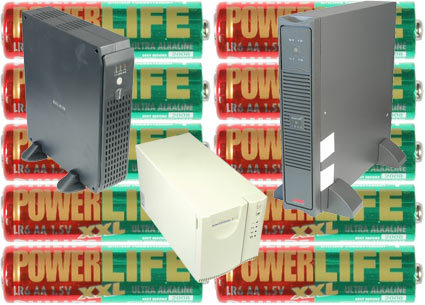UPSes To The Rescue
Got Power? Uninterruptible Power Supplies
Most of us spend a lot of time selecting system components. The processor, motherboard, memory, graphics card and the hard drive are scrutinized carefully. Coolers and power supplies have also become almost as important. Users want the best bang for their buck, while some primarily want performance. But as soon as a system is being used for 24/7 applications for the digital home or small business, another component becomes very important: steady power supply.
The steady provisioning of electric power has to begin with a suitable power supply unit (PSU), which must be capable of supplying sufficient energy at acceptable efficiency. It also cannot be too noisy, either. All parameters interrelate to each other, as a PSU with a higher level of energy efficiency will turn less power into heat. Hence, it won't require its fan(s) to rotate at comparatively high speeds. Most quality PSUs can compensate for up to an entire phase missing in the power grid's alternating current (AC). However, even the best power supply won't help you in case of a power outage.
UPS units (uninterruptible power supply) are designed to prevent systems from crashing in the event of a power outage. With the help of their software interfaces, users can shut down applications in progress and initiate a regular shutdown. Clearly, the main purpose is data protection.
But an UPS will not only be valuable in case of a total blackout, but also in case of a shorter power breakdown, which is known as a brownout. This type of power outage happens more frequently than you might think; flickering lamps, reset clock radios or a computer restarting out of the blue are clear indicators. Exchanging the clock radio for a model with a battery buffer or using a high-quality PC power supply will help, but it doesn't solve the basic problem: power supply isn't steady 100% of the time.
We looked at three mainstream UPS devices by APC, Belkin and Eaton/Powerware, which all are rated at 1000 VA and appear to be very similar. However, be careful with these power ratings, which apply to both effective and reactive power. Reactive power appears in all AC circuits with inductive or capacitive load, and puts the voltage and current out of phase, which has energy flowing back and forth. This reactive power cannot be used, but has to be considered, as it reduces the effective power of the three UPS devices to 600-670 W. Also, the battery capacity of an USV, among with its features, is something else that merits attention.
Join our discussion on this topic
Get Tom's Hardware's best news and in-depth reviews, straight to your inbox.

Patrick Schmid was the editor-in-chief for Tom's Hardware from 2005 to 2006. He wrote numerous articles on a wide range of hardware topics, including storage, CPUs, and system builds.
